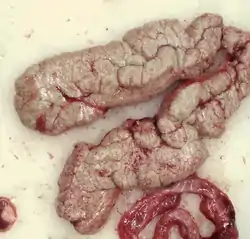Gonad
A gonad, sex gland, or reproductive gland[1] is a mixed gland that produces the gametes and sex hormones of an organism. Female reproductive cells are egg cells, and male reproductive cells are sperm.[2] The male gonad, the testicle, produces sperm in the form of spermatozoa. The female gonad, the ovary, produces egg cells. Both of these gametes are haploid cells. Some hermaphroditic animals (also some humans) have a type of gonad called an ovotestis.
| Gonad | |
|---|---|
 A pair of ovaries of Cyprinus carpio (common carp) placed in dissecting dish | |
| Identifiers | |
| MeSH | D006066 |
| FMA | 18250 |
| Anatomical terminology | |
Evolution
It is hard to find a common origin for gonads, but gonads most likely evolved independently several times.[3]
Regulation
The gonads are controlled by luteinizing hormone (LH) and follicle-stimulating hormone (FSH), produced and secreted by gonadotropes or gonadotrophins in the anterior pituitary gland.[4] This secretion is regulated by gonadotropin-releasing hormone (GnRH) produced in the hypothalamus.[5][6]
Development
Gonads start developing as a common primordium (an organ in the earliest stage of development), in the form of genital ridges,[7] which are only later differentiated to male or female sex organs (except when they are not differentiated). The presence of the SRY gene,[8] located on the Y chromosome and encoding the testis determining factor, usually determines male sexual differentiation. In the absence of the SRY gene from the Y chromosome, usually the female sex (ovaries instead of testes) will develop. The development of the gonads is a part of the development of the urinary and reproductive organs.
Disease
The gonads are subject to many diseases, such as hypergonadism, hypogonadism, agonadism, tumors, and cancer, among others.
Aging
Ovarian aging
A delay in having children is common in the developed world and this delay is often associated with ovarian infertility and subfertility. Ovarian aging is characterized by progressive decline of the quality and number of oocytes.[9] This decline is likely due, in part, to reduced expression of genes that encode proteins necessary for DNA repair and meiosis.[10][11] Such reduced expression can lead to increased DNA damage and errors in meiotic recombination.[9]
Testicular aging
The testes of older men often have sperm abnormalities that can ultimately lead to infertility.[12] These abnormalities include accumulation of DNA damage and decreased DNA repair ability.[12] During spermatogenesis in the testis, spontaneous new mutations arise and tend to accumulate with age.[13]
References
- "the definition of sex gland". Dictionary.com. Archived from the original on 22 July 2015. Retrieved 8 May 2018.
- "gonad (noun) American English definition and synonyms - Macmillan Dictionary". www.macmillandictionary.com. Archived from the original on 8 May 2018. Retrieved 8 May 2018.
- Schmidt-Rhaesa, Andreas (2007-08-30). The Evolution of Organ Systems. Oxford University Press. p. 252. ISBN 978-0-19-856668-7.
- "gonadotropin". The Free Dictionary. Mosby's Medical Dictionary, 8th edition. Elsevier. 2009. Retrieved 4 June 2012.
- John W. Kimball (12 February 2011). "Hormones of the Hypothalamus: Gonadotropin-releasing hormone (GnRH)". Kimball's Biology Pages. John W. Kimball (The Saylor Foundation). Archived from the original on 27 June 2012. Retrieved 4 June 2012.
- Marieb, Elaine (2013). Anatomy & physiology. Benjamin-Cummings. p. 915. ISBN 9780321887603.
- Schoenwolf, Gary C. (2015). Larsen's human embryology (Fifth ed.). Philadelphia, PA. p. 16. ISBN 9781455706846.
{{cite book}}: CS1 maint: location missing publisher (link) - "Human Developmental Genetics". Institut Pasteur. Archived from the original on 5 May 2012. Retrieved 4 June 2012.
- Park SU, Walsh L, Berkowitz KM. Mechanisms of ovarian aging. Reproduction. 2021 Jul 14;162(2):R19-R33. doi: 10.1530/REP-21-0022. PMID: 33999842; PMCID: PMC9354567
- Yang Q, Mumusoglu S, Qin Y, Sun Y, Hsueh AJ. A kaleidoscopic view of ovarian genes associated with premature ovarian insufficiency and senescence. FASEB J. 2021 Aug;35(8):e21753. doi: 10.1096/fj.202100756R. PMID: 34233068
- Turan V, Oktay K. BRCA-related ATM-mediated DNA double-strand break repair and ovarian aging. Hum Reprod Update. 2020 Jan 1;26(1):43-57. doi: 10.1093/humupd/dmz043. PMID: 31822904; PMCID: PMC6935693
- Dong S, Chen C, Zhang J, Gao Y, Zeng X, Zhang X. Testicular aging, male fertility and beyond. Front Endocrinol (Lausanne). 2022 Oct 13;13:1012119. doi: 10.3389/fendo.2022.1012119. PMID: 36313743; PMCID: PMC9606211
- Cioppi F, Casamonti E, Krausz C. Age-Dependent De Novo Mutations During Spermatogenesis and Their Consequences. Adv Exp Med Biol. 2019;1166:29-46. doi: 10.1007/978-3-030-21664-1_2. PMID: 31301044